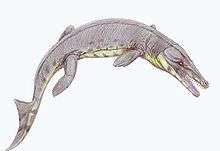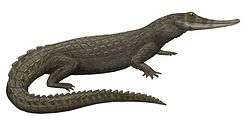Coelognathosuchia
| Coelognathosuchia Temporal range: Early Jurassic (Sinemurian) - Late Cretaceous (Maastrichtian, 196–65 Ma | |
|---|---|
 | |
| Skull of Goniopholis simus | |
| Scientific classification | |
| Kingdom: | Animalia |
| Phylum: | Chordata |
| Class: | Reptilia |
| Superorder: | Crocodylomorpha |
| Clade: | Neosuchia |
| Clade: | †Coelognathosuchia Martin et al. (in press) |
| Families | |
Coelognathosuchia is an extinct clade of neosuchian crocodyliforms that includes Goniopholididae and Pholidosauridae, two families of superficially crocodile-like aquatic crocodyliforms from the Mesozoic. Martin et al. (in press) named the clade after finding goniopholidids and pholidosaurids to group together in their phylogenetic analysis of crocodyliform evolutionary relationships. In their analysis, Pholidosauridae was monophyletic and Goniopholididae was paraphyletic, being an assemblage of successively more basal taxa within Coelognathosuchia. Coelognathosuchia itself was positioned near the base of the larger clade Neosuchia as the sister group to a clade containing the Early Cretaceous neosuchian Bernissartia and Eosuchia, the group that includes all modern crocodilians and their closest extinct relatives.[1]
Martin et al. named Coelognathosuchia from the Greek κοίλος (koílos, "concave"), γνάθος (gnáthos, "jaw") and σοῦχος (suchos, "crocodile"), after a small depression on the surface of the skull between the maxilla and jugal bones in both goniopholidids and pholidosaurs. Other diagonostic features of Coelognathosuchia include orbits (eye sockets) that are narrower than the frontal bone that separates them and smaller than the supratemporal fenestrae (two holes at the back of the skull roof) behind them, a notch between the premaxilla and maxilla at the tip of the snout, and the reduction or absence of the antorbital fenestrae (a pair of holes in the snout in front of each orbit).[1]
A close relationship between Goniopholididae and Pholidosauridae conflicts with the hypothesis that pholidosaurids are instead more closely related to the family Dyrosauridae.[1] This alternate phylogeny was found in many analyses, including Jouve et al. (2006),[2] Pol and Gasparini (2009),[3] and de Andrade et al. (2011), who named the clade Tethysuchia.[4] In both studies, Goniopholididae was found to be a more distantly related clade within Neosuchia.
References
- 1 2 3 Martin, J. E.; Lauprasert, K.; Buffetaut, E.; Liard, R.; Suteethorn, V. (2013). Angielczyk, Kenneth, ed. "A large pholidosaurid in the Phu Kradung Formation of north-eastern Thailand". Palaeontology: n/a. doi:10.1111/pala.12086.
- ↑ Jouve, S. P.; Iarochène, M.; Bouya, B. D.; Amaghzaz, M. (2006). "A new species of Dyrosaurus (Crocodylomorpha, Dyrosauridae) from the early Eocene of Morocco: Phylogenetic implications". Zoological Journal of the Linnean Society 148 (4): 603. doi:10.1111/j.1096-3642.2006.00241.x.
- ↑ Pol, D.; Gasparini, Z. (2009). "Skull anatomy of Dakosaurus andiniensis(Thalattosuchia: Crocodylomorpha) and the phylogenetic position of Thalattosuchia". Journal of Systematic Palaeontology 7 (2): 163. doi:10.1017/S1477201908002605.
- ↑ De Andrade, M. B.; Edmonds, R.; Benton, M. J.; Schouten, R. (2011). "A new Berriasian species of Goniopholis (Mesoeucrocodylia, Neosuchia) from England, and a review of the genus". Zoological Journal of the Linnean Society 163: S66. doi:10.1111/j.1096-3642.2011.00709.x.
| ||||||||||||||||||||||||||||||||||||||||||||||||||||||||||||||||||||||||||||||||||||||||||||||||||||||||||

